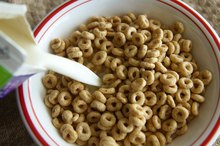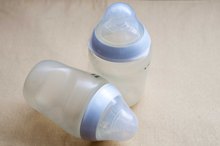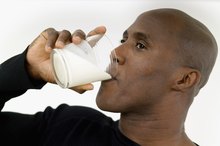Can a Child Get Food Poisoning from Milk Left Out All Day?
Something besides you loves to eat your food and drink your drinks: bacteria and viruses. When it comes to milk, leaving milk outside the refrigerator all day can contribute to food poisoning if your child drinks it 13. Understanding proper storage and handling of milk can help to keep food poisoning at bay and your child well 13.
If you are experiencing serious medical symptoms, seek emergency treatment immediately.
Bacterial Multiplication
Bacteria such as salmonella, listeria and E. coli commonly live on foods and can cause food poisoning in people of all ages 13. Some populations are more vulnerable than others, including the elderly, pregnant women and children, because their immune systems are not as potent as that of a typical adult. Certain environmental factors also make milk more prone to having bacteria develop, including being left at room temperature because warm temperatures foster bacterial multiplication. The longer milk is left out, the longer bacteria have to multiply and grow, which can lead to food poisoning if your child consumes the milk 13.
Milk Spoilage Symptoms
How to Test If Milk Is Spoiled
Learn More
Identifying bacteria in food can be difficult because bacteria do not always produce a smell or discoloration that can alert you to the fact that a food is contaminated. However, milk often develops a sour smell when it has been left out too long. Milk can also curdle, or develop small, rounded masses produced due to the presence of bacteria and/or yeast in the milk. Always have your child check with you before consuming a snack or beverage to make sure that you can evaluate it for potential food spoilage symptoms.
- Identifying bacteria in food can be difficult because bacteria do not always produce a smell or discoloration that can alert you to the fact that a food is contaminated.
Milk Handling
Because milk left out all day can contribute to food poisoning, it’s important to practice proper food handling 13. This includes keeping milk in the refrigerator when not in use. While refrigeration won’t keep bacteria from growing entirely, it will slow its growth. When milk reaches its expiration date, this signals a time when the bacteria could reach a too-high point. As a general rule, you do not want to give your child milk that has been left out for more than one hour, according to the Baby Center website. Milk left out longer than one hour could cause food poisoning, even if it does not smell or have curds in it 13.
Food Poisoning Symptoms
Raw Goat's Milk for Weight Loss
Learn More
If your child does consume milk that was left out all day, it’s important to observe him for symptoms of food poisoning 13. This includes upset stomach, stomach cramping, diarrhea and fever, according to the Kids Health website. In most instances, the food poisoning will resolve itself as your child experiences vomiting or diarrhea in an attempt to rid her body of the bacteria 13. However, you should seek immediate medical attention if you see blood in your child's stool or notice symptoms of dehydration, such as sunken eyes and a dry mouth.
Related Articles
References
- Kids Health: Food Poisoning
- Baby Center: How Long Can I Keep Formula Milk Out of the Fridge?
- MedlinePlus: Food Poisoning
- Centers for Disease Control and Prevention. (2019). Foodborne Illnesses and Germs.
- Cdc.gov. x. Burden of Foodborne Illness: Findings | Estimates of Foodborne Illness | CDC. Published 2018
- Cdc.gov.. Burden of Foodborne Illness: Findings | Estimates of Foodborne Illness | CDC. Published April 2019.
- Papaconstantinou HT, Thomas JS. Bacterial colitis. Clin Colon Rectal Surg. 2007;20(1):18–27. doi:10.1055/s-2007-970196
- Sobel J. Botulism. Clin Infect Dis. 2005;41(8):1167-73. doi:10.1086/444507
- Food Poisoning Symptoms. Centers for Disease Control and Prevention. Published October 11, 2019.
- Bintsis T. Foodborne pathogens. AIMS Microbiol. 2017;3(3):529–563. Published 2017 Jun 29. doi:10.3934/microbiol.2017.3.529
- Chris A. Norwalk-like viruses: when the runs can slow you down [published correction appears in CMAJ. 2003 Feb 18;168(4):400]. CMAJ. 2003;168(1):64–65. PMID: 12515788
- Pinchuk IV, Beswick EJ, Reyes VE. Staphylococcal enterotoxins. Toxins (Basel). 2010;2(8):2177–2197. doi:10.3390/toxins2082177
- Humphries RM, Linscott AJ. Laboratory diagnosis of bacterial gastroenteritis. Clin Microbiol Rev. 2015;28(1):3–31. doi:10.1128/CMR.00073-14
- Dekker JP, Frank KM. Salmonella, Shigella, and yersinia. Clin Lab Med. 2015;35(2):225–246. doi:10.1016/j.cll.2015.02.002
- Arendt S, Rajagopal L, Strohbehn C, Stokes N, Meyer J, Mandernach S. Reporting of foodborne illness by U.S. consumers and healthcare professionals. Int J Environ Res Public Health. 2013;10(8):3684–3714. Published 2013 Aug 19. doi:10.3390/ijerph10083684
- FDA. Are You Storing Food Safely? U.S. Food and Drug Administration. Published June 4, 2016.
- Public Affairs. Recalls and Outbreaks. FoodSafety.gov. Published November 21, 2019.
- Lund BM. Microbiological Food Safety for Vulnerable People. Int J Environ Res Public Health. 2015;12(8):10117–10132. Published 2015 Aug 21. doi:10.3390/ijerph120810117
- Smith JK, Burns S, Cunningham S, Freeman J, McLellan A, McWilliam K. The hazards of honey: infantile botulism. BMJ Case Rep. 2010;2010:bcr0520103038. Published 2010 Sep 29. doi:10.1136/bcr.05.2010.3038
- Krugman's Infectious Diseases of Children, 11th edition. Philadelphia, PA: 2004.
Writer Bio
Rachel Nall began writing in 2003. She is a former managing editor for custom health publications, including physician journals. She has written for The Associated Press and "Jezebel," "Charleston," "Chatter" and "Reach" magazines. Nall is currently pursuing her Bachelor of Science in Nursing at the University of Tennessee.









